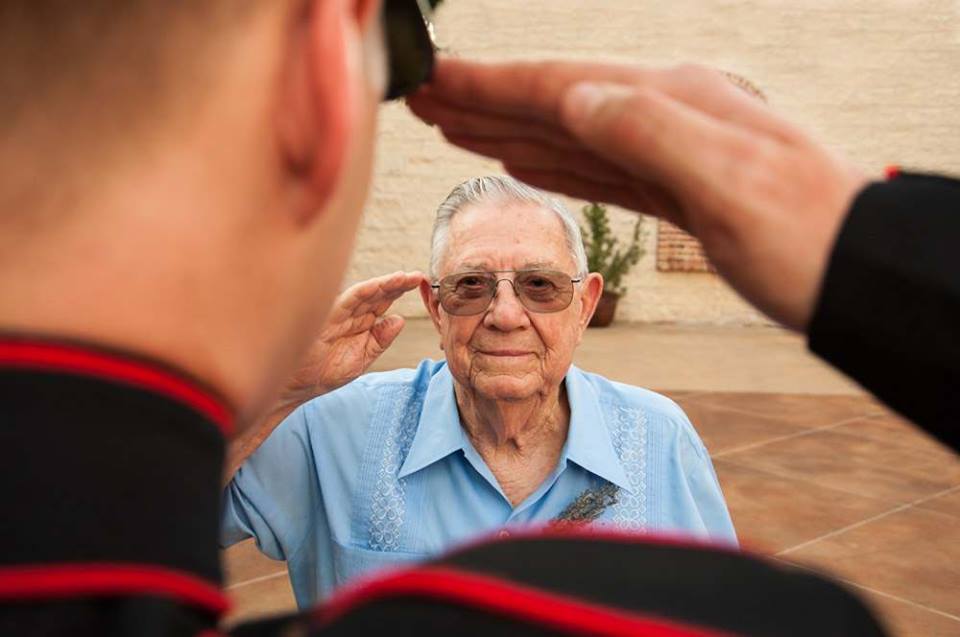Memories
When I returned home from World War II and the Korean War, my priorities were on my life as a civilian. I did not want to talk about what I had experienced. Today I frequently read letters from children whose father never talked about his war time experiences, but they want to know! They are asking if anyone knew their father; they want to know where he served and what he did. As a result, I decided to document, to the best of my memory, the time I served as a Marine from 1943 to 1952.
I find that writing about events that happened almost 70 years ago is like trying to write about your childhood. Most have been forgotten but some of the more eventful ones we tend to remember. It is also difficult to convey in words, the emotions that one experiences in combat.
After I retired in 1989, I attended a World War II reunion in San Antonio, Texas where I met with a few with whom I had served. Friendships bonded in combat are lasting and special. We laughed and we cried as we recalled memories from almost 50 years ago for the first time. It was interesting to see how these young men had aged, and I was thankful to be one of them. I have since attended many reunions and even served on the Board of Directors, but each year we shake hands more frequently for the last time.
Life is but a journey; the route we take is not always guided by our own choices, but by fate.
Pearl Harbor
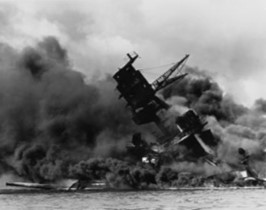 USS Arizona during the attack on Pearl Harbor, December 7, 1941
USS Arizona during the attack on Pearl Harbor, December 7, 1941
My journey began on August 13, 1925, during the Great Depression in Dallas Texas. I grew up enjoying the Big Bands and music to which one could understand the words. I was attending high school when the Japanese bombed Pearl Harbor on December 7, 1941, the event that changed the course of history and my life, as well as most others my age. Killed in the attack were Robert Carlisle, who lived directly across the street from me, and Tom Neal, who lived in the next block, both sailors aboard the USS Arizona. Also killed was a Marine, Harold W. Hope, the brother of my future wife. All three names are engraved on the memorial.
World War II had begun when Germany invaded Poland in 1939. The United States had managed to stay out of the war but provided aid to the countries fighting Germany and Japan. Japan had already invaded China and other countries, as it planned to conquer all of Asia. Japan needed raw materials for the homeland, but the U.S. Navy stood in the way of its plans to expand its conquests in the Pacific. The attack on Pearl Harbor on December 7, 1941 was to destroy the U.S. Navy with one powerful blow.
On December 8, 1941, President Franklin Delano Roosevelt declared a “State of War” existed between the United States and the Empire of Japan. Japan was allied with Germany and Italy, and they were known as the “Axis.” On December 11, Germany and Italy declared war on the United States. It was now a World War. The United States would now have to fight on two fronts, in Europe and the Pacific.
Patriotism ran high in the United States with many young men leaving high school to enlist. I remember how proud we were to see them home on leave, visiting school in their uniforms. I remember especially how impressed I was with those wearing Marine dress blue uniforms. I was never issued dress blues as I only served in time of conflict. I went from being a civilian to war and back twice; therefore I was never assigned to a duty station.
At age sixteen I passed a physical, along with George and Jack Gordon, brothers from my Sunday school class. My parents had to sign that I was 18 years old, and my Mother refused.
Others from my Sunday school class, brothers Earl and Jack Kerbow, were tail gunners on B-17 bombers. Earl was killed when shot down over Germany, and Jack was killed when shot down over Italy. Jack Morgan was a prisoner of war having been captured in the Philippines and was in the Bataan Death March. My best friends, Bill Zinn had joined the Navy and Charles Callaway, the Army Air Corps.
I Enlist
In July 1943, a month before my 18th birthday, I joined the Marines. The Sunday before I left Dallas, I was baptized in the Christian denomination. My Pastor dedicated the Sunday morning church service to me. He directed his sermon to me, saying that God did not just dwell in church on Sunday mornings but would be with me wherever I went. My Mother asked that I read the 23rd Psalm from the pulpit. I remember it well and how it helped to prepare me for the relationship that I was to have with God as I read, “Even though I walk through the valley of the shadow of death, you will be with me”.
When I reported for duty, I was surprised and pleased to see three of my friends from high school. We would be going as a group. We attended eight tough weeks of boot camp at the Marine Corps Recruit Depot in San Diego where I learned steps were called a "ladder," the floor a "deck," the bathroom a "head," etc. We ran obstacle courses and were taught discipline; for example, if you talked without permission, you wore a bucket over your head the rest of the day. We learned that our rifles were our best friend and how to use our bayonet.
After graduation, we each received a ten-day furlough. This time I was the Marine visiting high school, but in my dress greens, which were still pretty impressive. During this time I became engaged to my high school sweetheart. After my furlough, I was sent to Camp Pendleton at Oceanside, California where I received a six-week training course on a 30 caliber light machine gun. A machine gunner’s life expectancy is short, and we were trained to take his place if he was killed. At the end of the six week training, I was now ready to join the war.
Overseas
I sailed on December 23, 1943 aboard the escort aircraft carrier USS Corregidor for Pearl Harbor. We were at sea seven days. After a short stay at Pearl City, I sailed aboard the USS Arrow to Hilo on the island of Hawaii where in January 1944, I was assigned to A Company, 8th Marine Regiment, in the 2nd Marine Division. The division had just returned from capturing Tarawa, a small atoll in the Marshall Islands with a valuable airfield. The Japanese commander boasted “a thousand men could not take Tarawa in a hundred years.”
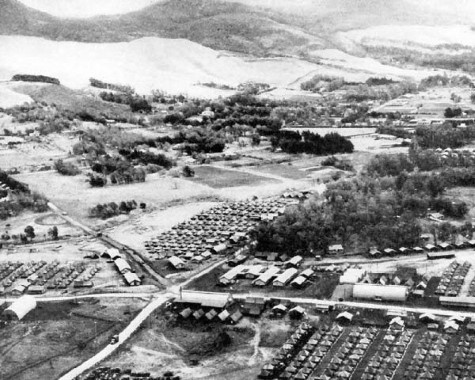 Camp Tarawa, Hawaii, 1944
Camp Tarawa, Hawaii, 1944
The U.S. Military, on the other hand, thought that after a bombardment from battleships and bombs, they would capture it by noon. Instead, it took the 2nd Marine Division 72 hours and at a very high cost. Movie news reels showed the bodies of bloated, floating dead Marines, which shocked our nation. I was a replacement for one of the Marines who had been killed at Tarawa. The 2nd Marine Division Camp was on Parker Ranch on the island of Hawaii, the largest island ranch in the world. Today, a monument stands at what was the entrance to the 2nd and 5th Marine Division Camps.
I received training in the use of a C-2 explosive that came in a satchel with a shoulder strap; it weighed twenty pounds. The strap could also be used as a sling for throwing into a cave or pillbox. My training also included the use of half pound blocks of TNT and a rocket launcher called a “bazooka.” My MOS (Military Occupation Specialty) was changed to “Infantry Assault Demolitionist.”
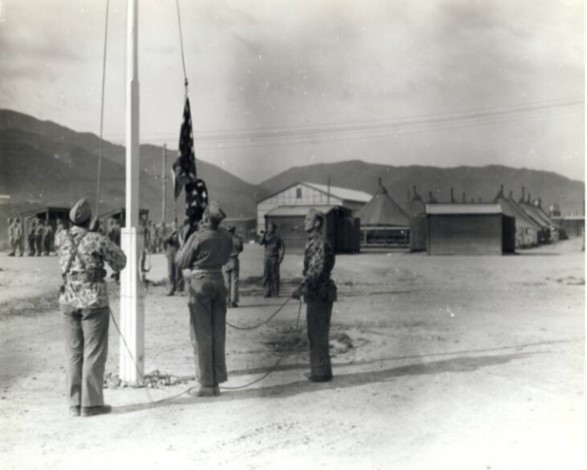 morning colors, Second Marine Division, Camp Tarawa, Hawaii, 1944
morning colors, Second Marine Division, Camp Tarawa, Hawaii, 1944
Platoons were randomly chosen from each regiment of the 2nd Marine Division to form a separate battalion, eventually designated as the 1st Battalion, 29th Marine Regiment of the 6th Marine Division, which was then forming on Guadalcanal. We were no longer a part of the 2nd Division, but attached to it.
In mid May 1944, we sailed with the 2nd Marine Division aboard the USS Neville (APA9) to invade Maui as a practice invasion. Ironically, the beach was much like the one we would invade later, complete with sugar mill, but we were not aware of this as our destination was still unknown. During the maneuvers, a Higgins boat hit the ramp of another boat that some of our company was in, and down went the ramp at sea! Just as the last Marine crawled over into another boat, it sank.
Prayers and Blessings
While on liberty in Honolulu on 21 May, several LST ships loaded with ammunition for the invasion exploded. The explosions could be heard and black smoke could be seen for miles, but it was classified as confidential information. We could not write home about anything we saw or where we were, as all mail was censored. We were not permitted to own a camera or keep a diary. Only when our letters stopped did our families know that we were at sea. My Mother told me how she would watch the newspapers for news of an invasion, since they always listed the units involved, so she would know if I was there. She told me how she worried about me, knowing I was in combat, and how she prayed constantly for my safe return. Only now, as a parent, can I imagine the concern and heartbreak she must have felt, the tears she shed, and the prayers that she prayed each day for my safe return.
We sailed from Pearl Harbor on Memorial Day, May 30, 1944. Our destination was still “Top Secret.” We learned on June 6 about D-Day in Europe, but we were occupied with our own D-Day to come on June 15 in the Pacific. We did not learn until we were at sea that our objective was the islands of Saipan and Tinian in the northern Marianas Islands. We were told the importance of taking the islands: that Japan would be within bombing range of our new B-29 bombers. They would be able to fly from Saipan or Tinian, bomb Japan, and return in one day – a distance of 3,000 miles round trip.
At dusk one evening, I watched a torpedo wake heading for our ship, but it missed by several feet aft. Two planes were launched from our escort aircraft carrier to search for the submarine, but as daylight faded the planes returned to the carrier. Our Chaplain was asked if he considered it ”Divine Intervention.” He said he did not know, but that “God works in mysterious ways.” And that we should be thankful and count our blessings.
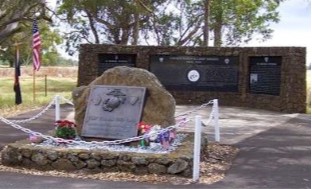 monument to the Marines who trained at Camp Tarawa, Hawaii, dedicated 1985 & 1998
monument to the Marines who trained at Camp Tarawa, Hawaii, dedicated 1985 & 1998
